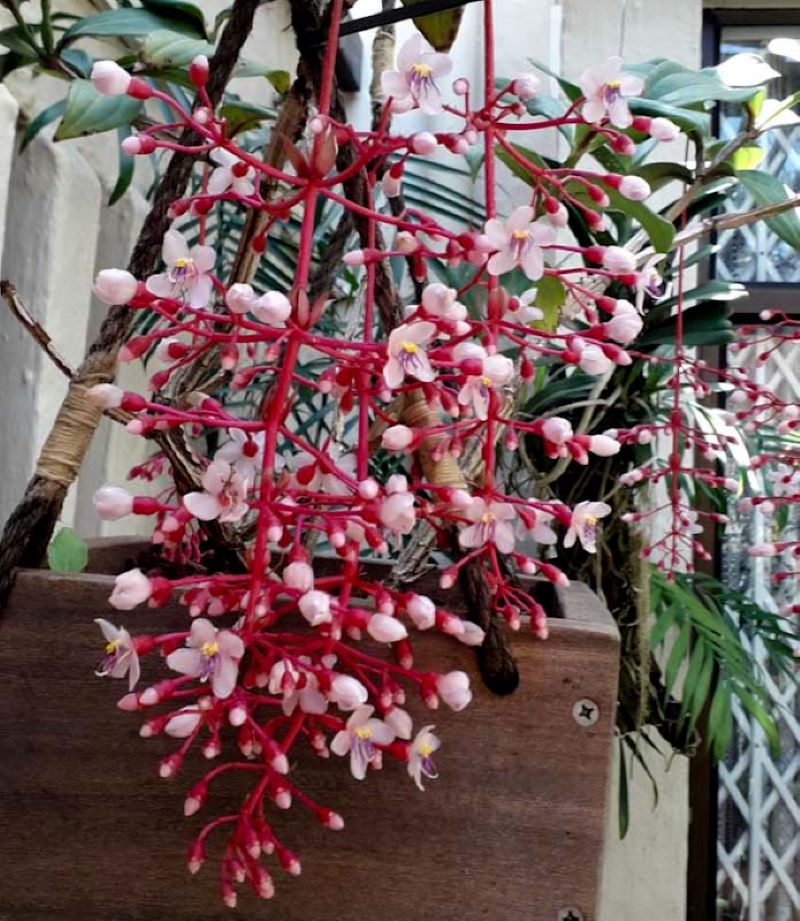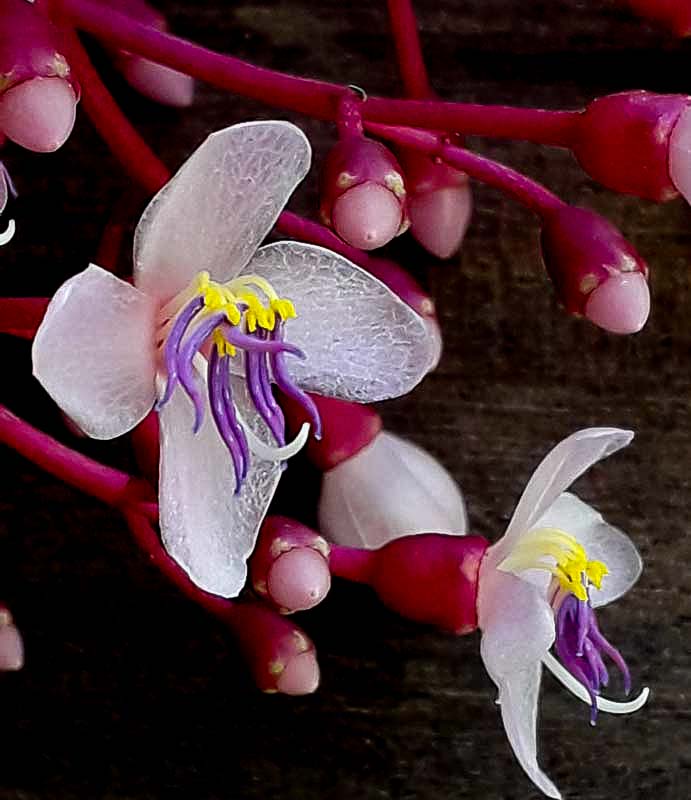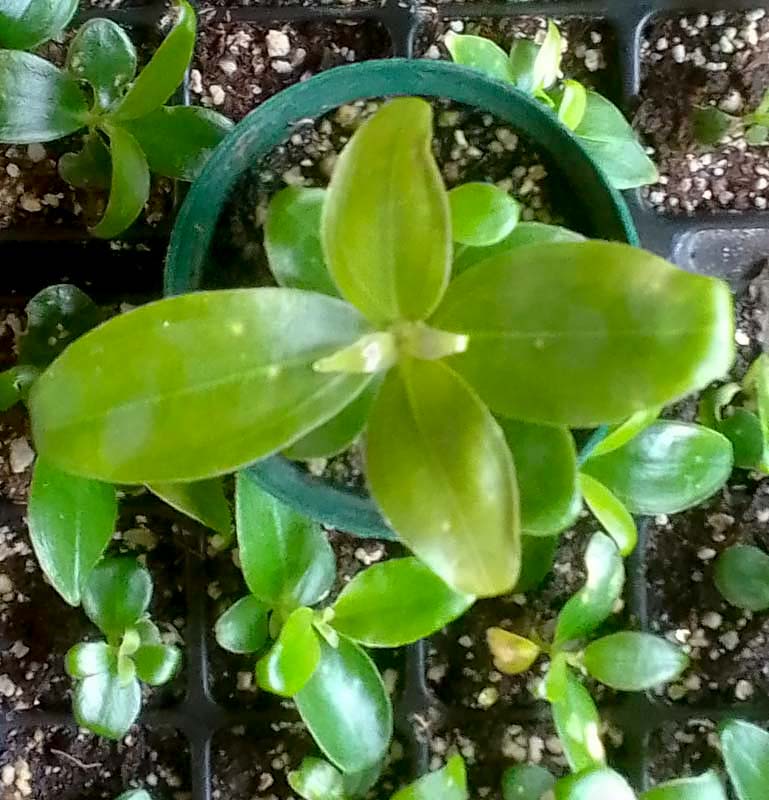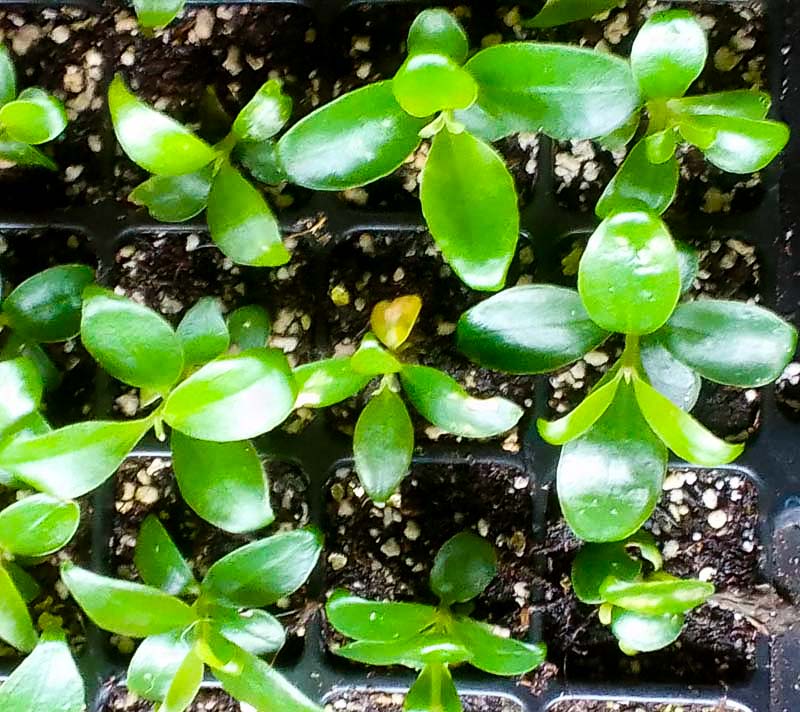Growing Medinilla
speciosa
Showy Asian Grapes
Medinilla speciosa plant in flower in a hanging basket well above the ground
Medinilla speciosa is a spectacular perennial epiphytic plant of the family Melastomataceae the same family as the beautiful and well know Tibouchina tree.
Distribution
Medinilla speciosa occurs
naturally in Asia and Southeast from the Nicobar Islands in the west to
Borneo, Java and the Philippines in the east. Its distribution includes
peninsular Malaysia Java, Sumatra, Lesser Sunda Islands, Sulawesi
and Moluccas. In much of this area the plants and in particular its
fruit is known as Parijoto.
Habitat
Medinilla speciosa is found
growing in high elevation mountain cloud forests at elevations between
300 metres (980 ft) and 750 metres (2,460 ft) above sea level.
Description
Medinilla speciosa which is a
very showy evergreen ornamental epiphyte reaches on average a height of
45–60 centimetres. Medinilla speciosa has woody branched stems and
opposite leathery green leaves up to 20 centimetres and 15 centimetres
wide, with prominent veins as is a prominent feature of plants
belonging to the family Melastomataceae.

The dainty small flower of Medinilla speciosa
The dainty small flowers are bright pink to red in colour are produced
in large panicles on numerous long pendulous sprays having reddish
stems. The flowers are followed by small rounded fruits which are at
first pink turning purple-blue almost black when ripe, this is where
the common name of Showy Asian Grapes comes from.

The dainty small flower of Medinilla speciosa
Landscape Uses
Medinilla speciosa plants can be grown as houseplants, greenhouse specimens as well as in the garden as general plants in areas with the correct climatic conditions such as in Durban, South Africa.
How to Grow Medinilla speciosa
Medinilla speciosa grows
naturally as an epiphyte high up in large trees in relatively cool
mountain cloud forest which dictates certain cultural requirements when
it comes to successfully growing this magnificent ornamental plant.
Growing Medinilla speciosa as well as Medinilla magnifica is very easy and rewarding as long as one understands the growing conditions required by the plants.
I have found that growing both Medinilla speciosa as well as Medinilla magnifica successfully outdoors that they need to be grown in hanging baskets or pots raised well off of the ground for a number of reasons that I will go into here. First and foremost, Medinilla plants are very susceptible to attack by root-knot nematodes that will cause so much damage to the root system that will lead to the point where the plant cannot properly absorb water and nutrients and will eventually die. This is probably the main reason why most growers have such limited success with these magnificent plants when they try to grow them in soil in the garden as regular garden plants. Secondly the flowers are produced on long pendulous flower stems that hand well down below the plants and if grown at or near to ground level the flowers land up lying on the ground where they cannot be seen and soon start to rot. Hanging the plants up in a basket or placing the pot they are grown in well above the ground allows the spectacular flowers to hang down below the plants and to be able to fully develop at the same time it keeps the plants away from easy attack by soil dwelling root knot nematodes.
As epiphytes Medinilla speciosa plants need to be grown in an open free draining growing medium much the same as epiphytic orchids require. In the past I have grown them in various mixtures of course orchid bark, charcoal, coconut fiber chips and coarse sieved leaf mould with great success. In fact they do not appear to be too fussy on the mixture as long as it is free draining and holds sufficient water to keep it moist between watering. The pots or baskets that they are grown in must have adequately large hole to allow for good drainage as well as for good gas exchange to the roots to ensure good and healthy growth of the roots without which one cannot have a healthy plant.
Wind
Growing Medinilla speciosa as well as Medinilla magnifica is very easy and rewarding as long as one understands the growing conditions required by the plants.
I have found that growing both Medinilla speciosa as well as Medinilla magnifica successfully outdoors that they need to be grown in hanging baskets or pots raised well off of the ground for a number of reasons that I will go into here. First and foremost, Medinilla plants are very susceptible to attack by root-knot nematodes that will cause so much damage to the root system that will lead to the point where the plant cannot properly absorb water and nutrients and will eventually die. This is probably the main reason why most growers have such limited success with these magnificent plants when they try to grow them in soil in the garden as regular garden plants. Secondly the flowers are produced on long pendulous flower stems that hand well down below the plants and if grown at or near to ground level the flowers land up lying on the ground where they cannot be seen and soon start to rot. Hanging the plants up in a basket or placing the pot they are grown in well above the ground allows the spectacular flowers to hang down below the plants and to be able to fully develop at the same time it keeps the plants away from easy attack by soil dwelling root knot nematodes.
As epiphytes Medinilla speciosa plants need to be grown in an open free draining growing medium much the same as epiphytic orchids require. In the past I have grown them in various mixtures of course orchid bark, charcoal, coconut fiber chips and coarse sieved leaf mould with great success. In fact they do not appear to be too fussy on the mixture as long as it is free draining and holds sufficient water to keep it moist between watering. The pots or baskets that they are grown in must have adequately large hole to allow for good drainage as well as for good gas exchange to the roots to ensure good and healthy growth of the roots without which one cannot have a healthy plant.
Wind
Medinilla speciosa plants do
not tolerate wind because they grow naturally in areas that do not
normally have strong winds and if subjected to windy conditions
especially when new leaves are growing they will become badly damaged,
so make sure your plant is grown in an areas that is very well
protected from the wind. On hot windy days if new leaves are developing
it may be necessary to water more than once a day or to employ an
automatic misting system that can mist them at predetermined intervals
during such weather conditions. This will also keep your plants cool
during the hottest part of the day in summer.
Light
Medinilla speciosa plants grow best in dappled shade, direct sun will scorch the leaves or cause leaf drop. Consider the Medinilla's natural habitat where as it grows nestled in the branches of large forest trees where it receives dappled sunlight, to grow them well they require similar conditions in the home garden.
Light
Medinilla speciosa plants grow best in dappled shade, direct sun will scorch the leaves or cause leaf drop. Consider the Medinilla's natural habitat where as it grows nestled in the branches of large forest trees where it receives dappled sunlight, to grow them well they require similar conditions in the home garden.
Watering and misting
Although Medinilla plants are
generally known as being tropical plants it is therefore expected that
they enjoy hot and humid conditions. This is not true they are plants
from the tropics but they grow as epiphytes in tropical cloud forests
at relatively high altitudes where the temperatures can be rather cool
and therefore do not particularly like very hot humid weather. For
instance, at the Singapore Botanical Gardens the various Medinilla
species are grown in a refrigerated glass house. Medinilla plants can
be grown very successfully in the hot humid coastal districts of
KwaZulu Natal but will need a little bit of above average care and
moisture to do well. A little inland at a height of 1500 feet above sea
level presents ideal growing conditions for these plants. Just bear in
mind that they are epiphytes from cool moist forests and that the
growing medium should be kept consistently moist but not soggy at all
times during the growing season. Watering will need to be reduced
during the winter months.
FertilizingAs an epiphyte Medinilla
speciosa is a light feeder however frequent feeding with a variety of
liquid fertilizers and strengths of about one quarter of the
recommended application rate is essential for good growth and flowering.
Pests and Diseases
As already mentioned epiphytic
Medinilla speciosa plants are highly susceptible to soil born root knot
nematodes which need to be avoided at all costs. These nematodes are
however easy to control with a number if nematicides that are both
extremely toxic and very difficult to obtain by the home gardener, such
as the highly toxic and highly dangerous Temik® belonging to
the family of carbamate insecticides the active ingredient being
Aldicarb also known as two step because it is said that if ingested one
will only make two steps. Another highly effective yet equally toxic
and dangerous nematicide is Curator® containing the active
ingredient Carbofuran. There is also another nematicide FOXAMYL which I
have not tried that is available in South Africa, but the sale of which
is probably as with the other two remedies only available to farmers
and registered pest control operators with the appropriate
endorsement. This being the case it is most important to ensure that
plants purchased have not been left standing in contact with the soil
at sales nurseries because they could very well be infected and to also
ensure that plants free of this pest do not become infested due to
negligence. If anyone reading this article does discover an infestation
of root knot nematodes, I have both the appropriate PCO certification
with endorsement as well as appropriate nematicides to deal with
the infestation.
The only other pests I have found attacking Medinilla speciosa plants are scale insects that attach to the mid veins of the leaves and occasionally red spider mites that are both easily dealt with by applying a little Efekto Insecticide Granules.
The only other pests I have found attacking Medinilla speciosa plants are scale insects that attach to the mid veins of the leaves and occasionally red spider mites that are both easily dealt with by applying a little Efekto Insecticide Granules.
Potting and Repotting
Please note that Medinilla
plants can grow to a considerable size in a rather small pot if watered
daily. This having been said please do not plant your Medinilla plant
in a pot that is too large as this will not lead to your Medinilla
growing more quickly but will only lead to rapid deterioration of the
growing medium and poor growth or death to the roots and eventually to
your plant. Only repot into a larger pot when the plant has achieved a
considerable size and then only into a pot that is one or two sizes
bigger than the pot it came out of.
Pruning Medinilla
Potted Medinilla speciosa plants need regular light pruning to keep shape and to encourage new vigorous growth and production of large numbers of flowers. This must be done immediately after flowering before the onset of new growth.
Propagating Medinilla
Cuttings
Medinilla cuttings are slow but root easily in a mix of damp sphagnum moss peat and perlite. Take a cutting with at least two leaves, remove the top two-thirds of each leaf to reduce transpiration and place under in a shaded cool place with a means to keep the cuttings as humid as possible. I have only dome propagation in a heated mist bed, but I would imaging a coke bottle that has had the bottom and cap remove placed over each cutting should do.
Seed
Medinilla speciosa plants can also be propagated easily from seeds which is my preferred method however it does take a bit of know how to achieve good results or any result at all. Medinilla speciosa produces fruits that have viable seed when ripe under favorable conditions.

A young medinilla speciosa plant growing in a small pot
After removing the seeds they can be lightly sown in seed trays on a
very thin layer of sphagnum moss peat that has good drainage under it.
The seed is then sprayed to drenching with a fungicide suitable for
preventing damping off. I use a mixture of the systemic fungicide
Benlate active ingredient Benomyl and Previcur active ingredient
Propamocarb mixed as directed on the packaging. The growing medium must
be kept constantly moist to achieve this I place the seed tray in a
plastic bag may take two to three years to reach flowering size.
Beware do not use coco peat it causes the germinating seed to become deformed and to die.

Once the seedlings have germinated and fully developed the first
two leaves I slowly open to acclimatize the young seedlings then
completely remove the seed tray from the plastic bag.
As soon as the young seedlings are large enough to handle at about 5 mm in height I carefully transplant then into multi growing trays with individual compartments of about 3cm in size until their roots have are have completely filled the space available at this stage they are transplanted into small pots not exceeding three times the volume of the trays. This is done repeatedly until the plants have grown into mature young plants of flowering size which should take about three years.
Medinilla cuttings are slow but root easily in a mix of damp sphagnum moss peat and perlite. Take a cutting with at least two leaves, remove the top two-thirds of each leaf to reduce transpiration and place under in a shaded cool place with a means to keep the cuttings as humid as possible. I have only dome propagation in a heated mist bed, but I would imaging a coke bottle that has had the bottom and cap remove placed over each cutting should do.
Seed
Medinilla speciosa plants can also be propagated easily from seeds which is my preferred method however it does take a bit of know how to achieve good results or any result at all. Medinilla speciosa produces fruits that have viable seed when ripe under favorable conditions.

A young medinilla speciosa plant growing in a small pot
Beware do not use coco peat it causes the germinating seed to become deformed and to die.

As soon as the young seedlings are large enough to handle at about 5 mm in height I carefully transplant then into multi growing trays with individual compartments of about 3cm in size until their roots have are have completely filled the space available at this stage they are transplanted into small pots not exceeding three times the volume of the trays. This is done repeatedly until the plants have grown into mature young plants of flowering size which should take about three years.
Other Uses
Medicinal
In Java, Indonesia, Parijoto
fruit the fruit of Medinilla speciosa is used medicinally for its
anti-inflammatory and anti-bacterial properties as a remedy for sores,
diarrhea anticancer, and antibacterial treatment. The fruit is
traditionally boiled and consumed as a drink and is sometimes mixed
with turmeric or ginger for added nutritional benefits.
Research is being done by a number of universities into the medicinal properties and used of the fruit of Medinilla speciosa.
Bioprospecting of parijoto fruit extract of Medinilla speciosa as antioxidant and immunostimulant: Phagocytosis activity of macrophage cells
THE 6TH INTERNATIONAL CONFERENCE ON BIOLOGICAL SCIENCE ICBS 2019: https://doi.org/10.1063/5.0016435 Published Online: 16 September 2020
Department of Biology, Faculty of Science, Institut Teknologi Sepuluh Nopember (ITS), Building H, ITS campus,Sukolilo, Surabaya, East Java, Indonesia, 60111
Postgraduate student of Department of Biology, Faculty of Science, Institut Teknologi Sepuluh Nopember (ITS), Building H, ITS campus, Sukolilo, Surabaya, East Java, Indonesia, 60111
Abstract.
Parijoto fruit of Medinilla speciosa is one of the fruits in Indonesia that contains high anthocyanin, which is a flavonoid compound that exerts beneficial effects on blood pressure, endothelial function, oxidative stress and as antioxidants.
As a food supplement
Parijoto fruit is small in size and round to oval in shape, growing in large clusters on angular, thick, and fibrous stems. The skin of the fruit is taut, smooth, and ripens from pink to a vibrant red-purple when ripe and the stems are also bright red-pink. Parijoto fruits are crunchy, soft, and slightly acidic with a sweet and sour, fruity flavor.
Nutritional Value
Parijoto fruits contain tannins, glycosides, saponins, and flavonoids, which contribute to the fruit’s high anti-inflammatory properties.
Applications
Parijoto fruit is predominately consumed raw and can be eaten fresh, out-of-hand, sprinkled over desserts, tossed into fruit and green salads, or muddled and mixed into fruit drinks and cocktails. When young, the fruit is also sometimes coated in vinegar to add flavor. In addition to raw preparations, Parijoto fruit can be cooked and processed into jams and syrups. The leaves of some varieties are also edible and add a sour flavor into stir-fries, curries, soups, and salads. Parijoto fruits should be consumed immediately after harvest for best quality and flavor, it will only keep 1-2 days when stored in the refrigerator.
Research is being done by a number of universities into the medicinal properties and used of the fruit of Medinilla speciosa.
Bioprospecting of parijoto fruit extract of Medinilla speciosa as antioxidant and immunostimulant: Phagocytosis activity of macrophage cells
THE 6TH INTERNATIONAL CONFERENCE ON BIOLOGICAL SCIENCE ICBS 2019: https://doi.org/10.1063/5.0016435 Published Online: 16 September 2020
Department of Biology, Faculty of Science, Institut Teknologi Sepuluh Nopember (ITS), Building H, ITS campus,Sukolilo, Surabaya, East Java, Indonesia, 60111
Postgraduate student of Department of Biology, Faculty of Science, Institut Teknologi Sepuluh Nopember (ITS), Building H, ITS campus, Sukolilo, Surabaya, East Java, Indonesia, 60111
Abstract.
Parijoto fruit of Medinilla speciosa is one of the fruits in Indonesia that contains high anthocyanin, which is a flavonoid compound that exerts beneficial effects on blood pressure, endothelial function, oxidative stress and as antioxidants.
As a food supplement
Parijoto fruit is small in size and round to oval in shape, growing in large clusters on angular, thick, and fibrous stems. The skin of the fruit is taut, smooth, and ripens from pink to a vibrant red-purple when ripe and the stems are also bright red-pink. Parijoto fruits are crunchy, soft, and slightly acidic with a sweet and sour, fruity flavor.
Nutritional Value
Parijoto fruits contain tannins, glycosides, saponins, and flavonoids, which contribute to the fruit’s high anti-inflammatory properties.
Applications
Parijoto fruit is predominately consumed raw and can be eaten fresh, out-of-hand, sprinkled over desserts, tossed into fruit and green salads, or muddled and mixed into fruit drinks and cocktails. When young, the fruit is also sometimes coated in vinegar to add flavor. In addition to raw preparations, Parijoto fruit can be cooked and processed into jams and syrups. The leaves of some varieties are also edible and add a sour flavor into stir-fries, curries, soups, and salads. Parijoto fruits should be consumed immediately after harvest for best quality and flavor, it will only keep 1-2 days when stored in the refrigerator.
Fertilizing
I feed frequently using a very dilute amount of a variety of plant feeds such as
EasyGro™ Flower and Fruit
is a 3:1:6(46) water soluble fertilizer, high in concentrations of Potassium ideally suitable for crops during the flowering and fruiting stages.
SEAGRO™ Bio-Fertiliser
Bionutrient with Enhanced Amino Acids. A fish emulsion rich in micro & macro elements and 17 amino acids. Seagro is used as organic fertilizer in agricultural practices for maintenance of crop health. Seagro has a remarkable impact on crop quality as well as yield through the activation of key metabolic processes. Seagro serves not only as a nutrition and stress reliever, but also plays an important role in the vitality of the microbial population in the soil.
Nitrosol Original Biological Fertiliser
is the original formulation developed by Dr. Peter Kauzal, a veterinary surgeon, from ruminant blood and bone. Nitrosol Original has a balanced NPK of 11.5.7 plus trace elements and minerals and recommended for use in all horticultural crops and home garden.
Fulvic acid.
Fulvic acid is group of chemicals formed when plants and animals break down. It is found in the humus (organic matter) part of soil and peat, and is also found in streams and lakes.
Fulvic acid benefits of increases root respiration and formation,enhance plant growth and yield. Humic fulvic acid can enhances pH buffering capacity, enhances photosynthesis and respiration, increases cationic exchange.
Brings about an improvement in the transport of nutrients, making them available in the areas of need. Increases the synthesis of proteins and nucleic acids, which will facilitate the action of enzymes formed with some amino acids and micro-nutrients.
| Home |
Contact | |
| Green Roof |
Rehabilitation |
|
| Landscaping |
Weed |
|
 |
 |